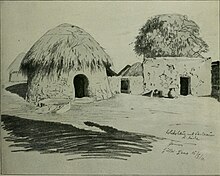Goulfey (Sultanate)
Goulfey (or Gulfey , rarely also Gulfei or Gulfeil ) was a sultanate of the Kotoko in the far north of today's Cameroon , named after the city of the same name , which lies on the Cameroonian side of the Logone river , about 30 km northwest of N'djamena . The sultanate was also a city-state at the same time , since, like the other Kotoko sultanates, it primarily consisted of the city and the surrounding area. For a long time, the capital was surrounded by a wall, which is no longer there today. The fate of the rather small sultanate is closely linked to the Makari Sultanate and is therefore sometimes referred to as Makari-Goulfey .
The Chadian- speaking Kotoko are divided into several subgroups, the Malgbe people of Goulfey .
The Kotoko sultanates had been subjugated by Kanem-Bornu early on and existed as vassal states in the southeast of the great empire. When the area was annexed by the French colonial empire, the colonial administrator Émile Gentil transferred the land of the Kotoko to Jaggara , the first Sheikh of the Shua Arabs , who had joined the French. The sovereign territory called the Serbewel Sultanate with the capital Goulfey, which was still subject to the French colonial administration, could not consolidate itself. The disempowered rulers of the Kotoko sultanates Makari and Afade raised an army and moved towards Goulfey. The punitive expedition started by the French was paradoxically directed against Shuwa Arabs and not against the insurgents. Since Jaggara was now deprived of its power base, the colonial administration initiated a reorganization of the country. Following the example of the Kotoko sultanates, the country was divided into five cantons, namely Goulfey, Makari, Wulki , Afade and Bodo . Further south there was at least the Kotoko Sultanate of Logone-Birni , which was not affected by the unrest, as it had obviously never been integrated into the Serbewel Sultanate.
The sultans of the individual states still exist today, but they only have representative roles.
In the 15th century Islam was introduced in Goulfey, where it mixed with the local belief in the city god Waran . This hybrid form had integrated the regional cults to such an extent that one can hardly speak of Islam in the true sense of the word. Since around 1985, Sunnism and Wahhabism have taken hold and shaken Goulfey's cultural landscape badly.
Individual evidence
- ↑ Malgbe | Ethnologue (English) Source: Ethnologue, accessed on October 26, 2015
- ↑ Ethnoarcheology of Shuwa-Arab-Settlements by Augustin Holl (English) Source: Google Books, accessed on October 26, 2015
- ↑ Islam et Politique au Sultanat de Goulfey (French, partly also in English and German) Source: www.unifr.ch, accessed on October 26, 2015
